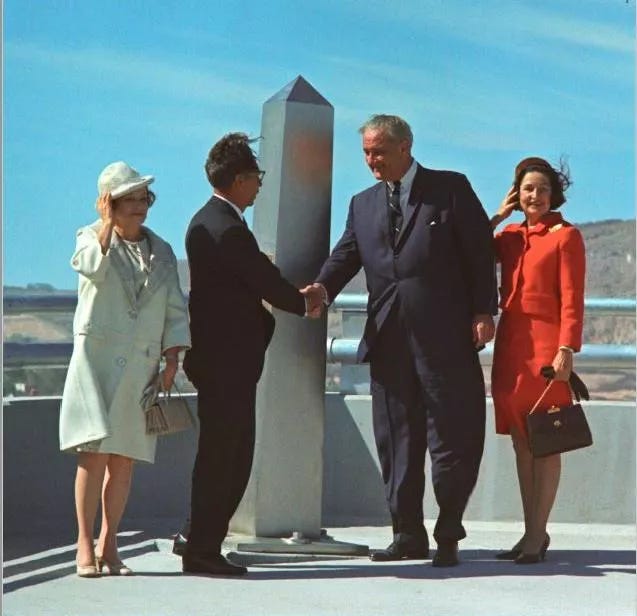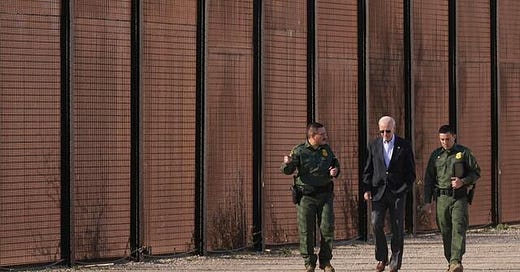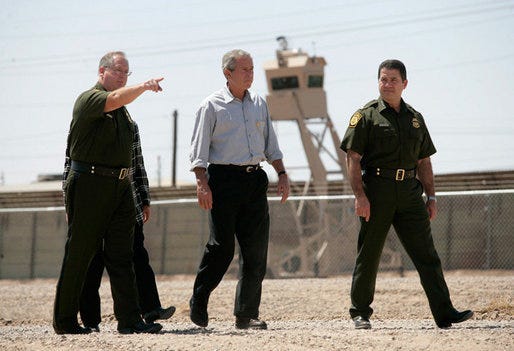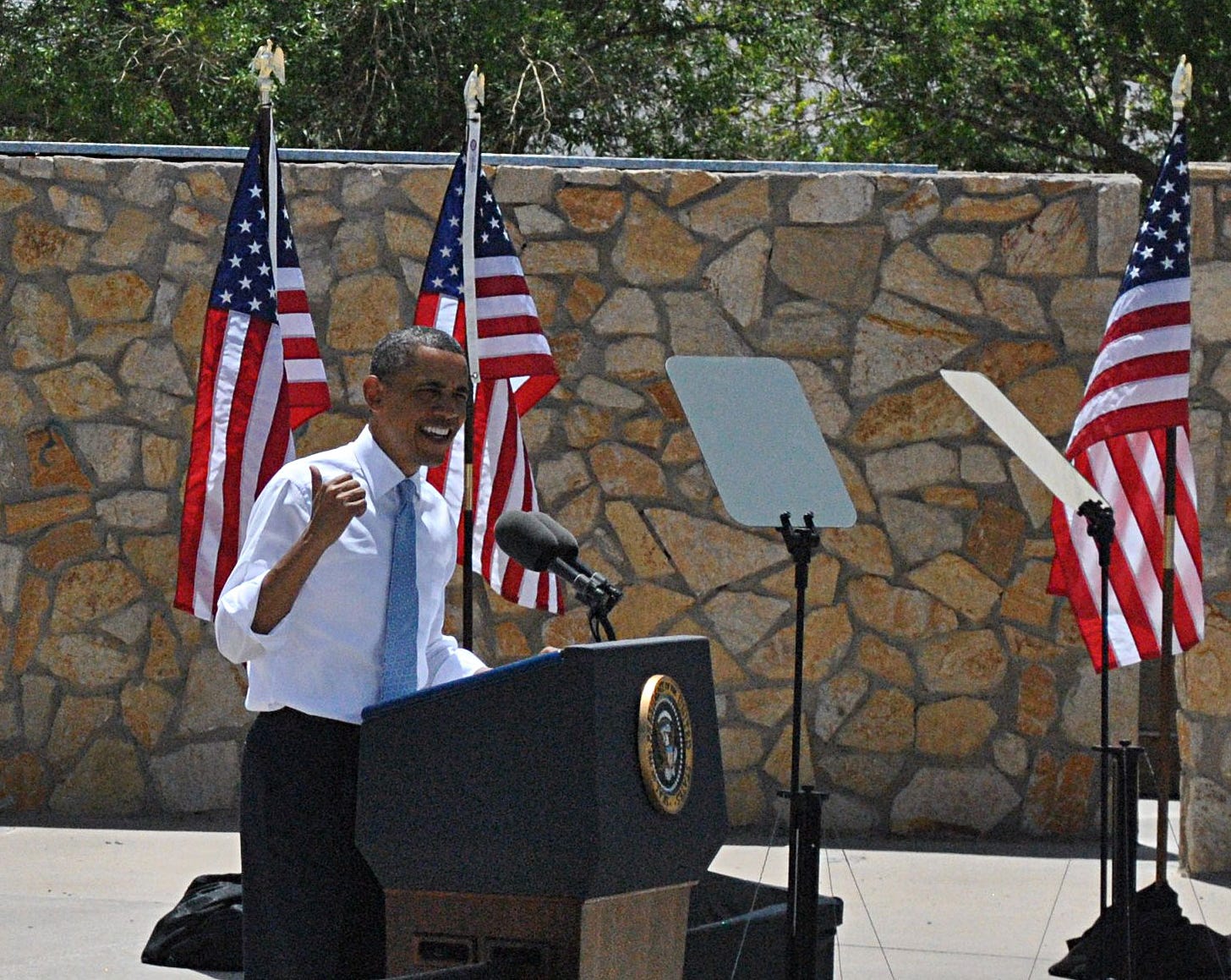When I searched for images of presidents visiting the border wall, I couldn’t find one of Barack Obama.
There wasn’t one like this of Joe Biden, taken yesterday (Sunday January 8):
There wasn’t one like this of Donald Trump:
And there wasn’t one like this of George W. Bush:
No, the only image I could find of Obama’s visit to the border was of him giving an immigration-related speech at the Chamizal National Memorial. It abuts the international boundary, but is a very different kind of border space than the ones other presidents visited, in the shadows of the militarized fence.
Located in El Paso—where all of these other pictures were also taken, by the way—the Chamizal memorial commemorates the site where, in 1967, U.S. President Lyndon Johnson and Mexican President Gustavo Diaz Ordaz ended a land dispute caused by the shifting course of the Rio Grande/Rio Bravo. By the late nineteenth century, the river had moved south, relocating about 600 acres of land to the United States that, according to the treaty that ended the U.S.-Mexico War, belonged to Mexico. Johnson and Diaz Ordaz settled the matter by dividing the land—about 400 acres for Mexico, and 200 for the United States. With its portion, the United States built the Chamizal National Memorial where Obama spoke. It was supposed to be a monument to the successes of international diplomacy; two countries coming together to solve their disputes peacefully. As the National Park Service’s Chamizal webpage puts it, “We celebrate the cultures of the borderlands to promote the same mutual respect that helped to diplomatically resolve an international disagreement.”

Obama understood the symbolism of the place. The press release announcing his May 2011 visit said he would talk about “our nation’s 21st century economic and security needs,” but also that he would “discuss how Americans can work together to foster a constructive national conversation on this important issue as we work to build a bipartisan consensus in Congress.” Typically for him, Obama emphasized bringing Americans together—both north and south of the border—instead of dividing us.
I’m not defending Obama’s record on immigration, but I am suggesting that he maybe grasped something about visiting the border that Biden apparently does not. Namely, how Republicans would use his visit and the photos of him in front of the border wall as a cudgel with which to beat him.
Whether it’s true or not, media reported that Biden’s visit was a response to Republican criticism that he hadn’t visited the border despite two years in office. But then House Speaker Kevin McCarthy dismissed Biden’s visit as a “photo op,” and blamed him for creating “the most dangerous border crisis in American history.” Texas Governor Greg Abbott greeted Biden at El Paso International Airport, handed him a letter enumerating his alleged failures to secure the border, and then told reporters that Biden’s visit was “nothing but for show.”
Yes, that’s right: Republicans slam Biden for not visiting the border, and then slam him when he does. To be clear, such hypocrisy demonstrates how Republicans also play politics with the border; they haven’t come to the table to negotiate a deal, which makes it seem like they’re more interested in posturing than getting something done. But it’s also one of many signs that Democrats are in a Catch 22 when it comes to the border and immigration; they’re damned if they do, and damned if they don’t. Biden walked right into the trap Republicans have repeatedly laid, whereas Obama, by deciding to visit the Chamizal National Memorial instead of the wall—even though this, too, was certainly a performance—was playing his own game.
When it comes to immigration, there are certainly more important things to talk about than the meaning of performative visits to the border. But on the substance of the issues, neither party has seemed willing to do anything more than apply bandaids. And to the extent that the Biden administration’s announced measures are meaningful efforts—to dissuade migrants from embarking on a dangerous journey (even if it’s no more dangerous than the decision to stay home), to encourage them to apply for asylum from their home countries and on new apps, and to increase the number of migrants who can temporarily enter, apply for asylum, and work in the United States—none of them required him to visit the border. Biden could have done this from Washington, where he also could have been briefed by the Border Patrol officers who “inspected” the wall with him.** So, maybe the answer is to just stay home and do the work there, instead of playing the game on Republicans’ terms?
**Speaking of inspecting the wall, I can’t tell for the life of me what that’s all about. What does it mean to inspect the wall? Is he looking for vulnerabilities? Admiring its strength, despite its manifest ineffectiveness? After all, 1.7 million unauthorized migrants entered the United States between October 2021 and October 2022—a level not reached since 1960—even after the wall construction of the Trump years.







